India–Japan relations
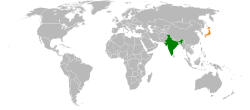 |
|
India |
Japan |
|---|---|
.jpg)
India–Japan relations (Japanese: 日印関係 Hepburn: Nichiinkankei) and (Hindi: भारत-जापान सम्बन्ध, translit. Bhārata - jāpāna sambandha) have traditionally been strong. For centuries, the people of India and Japan have engaged in cultural exchanges, primarily as a result of Buddhism, which spread indirectly from India to Japan, via China and Korea. The people of India and Japan are guided by common cultural traditions including the heritage of Buddhism, and share commitment to the ideals of democracy, tolerance, pluralism and open society. India and Japan, two of the largest and oldest democracies in Asia, having a high degree of congruence of political, economic and strategic interests, view each other as partners that have responsibility for and are capable of responding to global and regional challenges. India is the largest recipient of Japanese official development assistance (ODA).[1] As of 2013, bilateral trade between India and Japan stood at US$16.31 billion and is expected to reach US$50 billion by 2019-20.
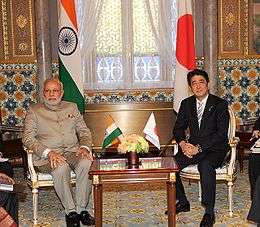

India and Japan were enemies in World War II, but political relations between the two nations have remained warm since India's independence. Japanese companies, such as Sony, Toyota, and Honda, have manufacturing facilities in India, and with the growth of the Indian economy, India is a big market for Japanese firms. Japanese firms in fact, were some of the first firms to invest in India. The most prominent Japanese company to have an investment in India is automobiles multinational Suzuki, which is in partnership with Indian automobiles company Maruti Suzuki, the largest car manufacturer in the Indian market, and a subsidiary of the Japanese company.
In December 2006, Indian Prime Minister Manmohan Singh's visit to Japan culminated in the signing of the "Joint Statement Towards Japan-India Strategic and Global Partnership". Japan has helped finance many infrastructure projects in India, most notably the Delhi Metro system. Indian applicants were welcomed in 2006 to the JET Programme, starting with just one slot available in 2006 and 41 in 2007. Also, in the year 2007, the Japanese Self-Defence Forces and the Indian Navy took part in a joint naval exercise in the Indian Ocean, known as Malabar 2007, which also involved the naval forces of Australia, Singapore and the United States. The year 2007 was declared "India-Japan Friendship Year."[1]
According to a 2013 BBC World Service Poll, 42% of Japanese people think India's international impact is mainly positive, with 4% considering it negative.[2]
Historical relations
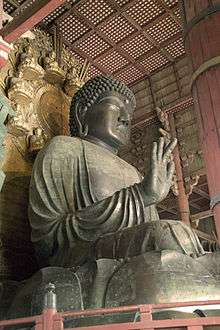

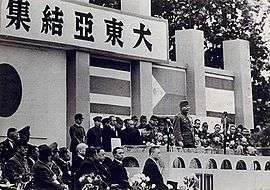
Cultural exchanges between India and Japan began early in the 6th century with the introduction of Buddhism to Japan from India. The Indian monk Bodhisena arrived in Japan in 736 to spread Buddhism and performed eye-opening of the Great Buddha built in Tōdai-ji,[1] and would remain in Japan until his death in 760. Buddhism and the intrinsically linked Indian culture had a great impact on Japanese culture, still felt today, and resulted in a natural sense of amiability between the two nations.[3]
As a result of the link of Buddhism between India and Japan, monks and scholars often embarked on voyages between the two nations. Buddhist monks from India had been visiting Japan from the 8th century.[4] Ancient records from the now-destroyed library at Nalanda University in India describe scholars and pupils who attended the school from Japan.[5] One of the most famous Japanese travellers to the Indian subcontinent was Tenjiku Tokubei (1612–1692), named after Tenjiku ("Heavenly Abode"), the Japanese name for India.
The cultural exchanges between the two countries created many parallels in their folklore. Modern popular culture based upon this folklore, such as works of fantasy fiction in manga and anime, sometimes bear references to common deities (deva), demons (asura) and philosophical concepts. The Indian goddess Saraswati for example, is known as Benzaiten in Japan. Brahma, known as 'Bonten', and Yama, known as 'Enma', are also part of the traditional Japanese Buddhist pantheon. In addition to the common Buddhist influence on the two societies, Shintoism, being an animist religion, is similar to the animist strands of Hinduism, in contrast to the religions present in the rest of the world, which are monotheistic. Sanskrit, a classical language used in Buddhism and Hinduism, is still used by some ancient Chinese priests who immigrated to Japan, and the Siddhaṃ script is still written to this day, despite having passed out of usage in India. It is also thought that the distinctive torii gateways at temples in Japan, may be related to the torana gateways used in Indian temples.
In the 16th century, Japan established political contact with Portuguese colonies in India. The Japanese initially assumed that the Portuguese were from India and that Christianity was a new "Indian faith". These mistaken assumptions were due to the Indian city of Goa being a central base for the Portuguese East India Company and also due to a significant portion of the crew on Portuguese ships being Indian Christians.[6] Throughout the 16th and 17th centuries, Indian lascar seamen frequently visited Japan as crew members aboard Portuguese ships, and later aboard British ships in the 18th and 19th centuries.[7]
During the anti-Christian persecutions in 1596, many Japanese Christians fled to the Portuguese colony of Goa in India. By the early 17th century, there was a community of Japanese traders in Goa in addition to Japanese slaves brought by Portuguese ships from Japan.[8]
Relations between the two nations have continued since then, but direct political exchange began only in the Meiji era (1868–1912), when Japan embarked on the process of modernisation.[9] Japan-India Association was founded in 1903.[10] Further cultural exchange occurred during the mid-late 20th century through Asian cinema, with Indian cinema and Japanese cinema both experiencing a "golden age" during the 1950s and 1960s. Indian films by Satyajit Ray, Guru Dutt were influential in Japan, while Japanese films by Akira Kurosawa, Yasujirō Ozu and Takashi Shimizu have likewise been influential in India.
Indian Independence Movement
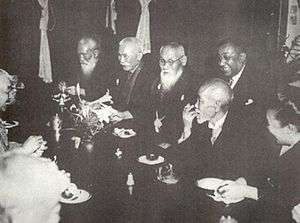
Japan’s emergence as a power in the early 20th century was positively viewed in India and symbolised what was seen as the beginning of an Asian resurgence. In India, there was great admiration for Japan’s post-war economic reconstruction and subsequent rapid growth.[11] Sureshchandra Bandopadhyay, Manmatha Nath Ghosh and Hariprova Takeda were among the earliest Indians who visited Japan and had written on their experiences there.[12] Correspondences between distinguished individuals from both nations had a noticeable increase at the time; historical documents show a friendship between Japanese thinker Okakura Tenshin and Indian writer Rabindranath Tagore, Okakura Tenshin and Bengali poet Priyamvada Banerjee.[13] As part of the British Empire, many Indians resented the British rule. The Anglo-Japanese Alliance was ended on 17 August 1923. As a result, during the two World Wars, the INA adopted the "an enemy of our enemy is our friend" attitude, legacy that is still controversial today given the war crimes committed by Imperial Japan and its allies.
Many Indian independence movement activists escaped from British rule and stayed in Japan. The leader of the Indian Independence Movement, Rash Behari Bose created India–Japan relations. Future prime minister Tsuyoshi Inukai, pan-Asianist Mitsuru Tōyama and other Japanese supported the Indian Independence movement. A. M. Nair, a student from India, became an Independence Movement activist. Nair supported Netaji Subhas Chandra Bose during the war and Justice Radha Binod Pal after the war.
In 1899 Tokyo Imperial University set up a chair in Sanskrit and Pali, with a further chair in Comparative religion being set up in 1903. In this environment, a number of Indian students came to Japan in the early twentieth century, founding the Oriental Youngmen's Association in 1900. Their anti-British political activity caused consternation to the Indian Government, following a report in the London Spectator.
During World War II
Since India was under British rule when World War II broke out, it was deemed to have entered the war on the side of the Allies. Over 2 million Indians participated in the war; many served in combat against the Japanese who conquered Burma and reached the Indian border. Some 67,000 Indian soldiers were captured by the Japanese when Singapore surrendered in 1942, many of whom later became part of the Indian National Army (INA). In 1944-45, the combined British and Indian forces defeated the Japanese in a series of battles in Burma and the INA disintegrated.[14]
Indian National Army
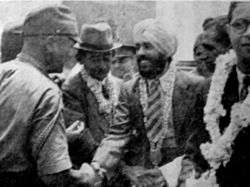
Subhas Chandra Bose, who led the Azad Hind, a nationalist movement which aimed to end the British raj through military means, used Japanese sponsorship to form the Azad Hind Fauj or Indian National Army (INA). The INA was composed mainly of former prisoners of war from the British Indian Army who had been captured by the Japanese after the fall of Singapore. They joined primarily because of the very harsh, often fatal conditions in POW camps. The INA also recruited volunteers from Indian expatriates in Southeast Asia. Bose was eager for the INA to participate in any invasion of India, and persuaded several Japanese that a victory such as Mutaguchi anticipated would lead to the collapse of British rule in India. The idea that their western boundary would be controlled by a more friendly government was attractive. Japan never expected India to be part of its Greater East Asia Co-Prosperity Sphere.[15]
The Japanese Government built, supported and controlled the Indian National Army and the Indian Independence League.. Japanese forces included INA units in many battles, most notably at the U Go Offensive at Manipur. The offensive culminated in Battles of Imphal and Kohima where the Japanese forces were pushed back and the INA lost cohesion.
Modern relations


At the International Military Tribunal for the Far East, Indian Justice Radhabinod Pal became famous for his dissenting judgement in favour of Japan. The judgement of Justice Radhabinod Pal is remembered even today in Japan.[1] This became a symbol of the close ties between India and Japan.
A relatively well-known result of the two nations' was in 1949, when India sent the Tokyo Zoo two elephants to cheer the spirits of the defeated Japanese empire.[16][17]
India refused to attend the San Francisco Peace Conference in 1951 due to its concerns over limitations imposed upon Japanese sovereignty and national independence.[11][18] After the restoration of Japan's sovereignty, Japan and India signed a peace treaty, establishing official diplomatic relations on 28 April 1952, in which India waived all reparation claims against Japan.[11] This treaty was one of the first treaties Japan signed after World War II.[3] Diplomatic, trade, economic, and technical relations between India and Japan were well established. India's iron ore helped Japan's recovery from World War II devastation, and following Japanese Prime Minister Nobusuke Kishi's visit to India in 1957, Japan started providing yen loans to India in 1958, as the first yen loan aid extended by Japanese government.[3] Relations between the two nations were constrained, however, by Cold War politics. Japan, as a result of World War II reconstruction, was a U.S. ally, whereas India pursued a non-aligned foreign policy, often leaning towards the Soviet Union. Since the 1980s, however, efforts were made to strengthen bilateral ties. India’s ‘Look East’ policy posited Japan as a key partner.[11] Since 1986, Japan has become India's largest aid donor, and remains so.[3]
Relations between the two nations reached a brief low in 1998 as a result of Pokhran-II, an Indian nuclear weapons test that year. Japan imposed sanctions on India following the test, which included the suspension of all political exchanges and the cutting off of economic assistance. These sanctions were lifted three years later. Relations improved exponentially following this period, as bilateral ties between the two nations improved once again,[19] to the point where the Japanese prime minister, Shinzo Abe was to be the chief guest at India's 2014 Republic Day parade.[20]
In 2014, the Indian PM Narendra Modi visited Japan. During his tenure as the Chief Minister of Gujarat, Modi had maintained good ties with the Japanese PM Shinzo Abe. His 2014 visit further strengthened the ties between the two countries, and resulted in several key agreements, including the establishment of a "Special Strategic Global Partnership".[21][22]
Modi visited Japan for the second time as Prime Minister in November 2016. During the meeting, India and Japan signed the "Agreement for Cooperation in Peaceful Uses of Nuclear Energy", a landmark civil nuclear agreement, under which Japan will supply nuclear reactors, fuel and technology to India. India is not a signatory to the non-Proliferation Treaty (NPT), and is the only non-signatory to receive an exemption from Japan.[23] The two sides also signed agreements on manufacturing skill development in India, cooperation in space, earth sciences, agriculture, forestry and fisheries, transport and urban development.[24]
Economic
In August 2000, Japanese Prime Minister Mori visited India. At this meeting, Japan and India agreed to establish "Japan-India Global Partnership in the 21st Century." Indian Prime Minister Vajpayee visited Japan in December, 2001, where both Prime Ministers issued "Japan-India Joint Declaration." In April, 2005, Japanese Prime Minister Koizumi visited India and signed Joint Statement "Japan-India Partnership in the New Asian Era: Strategic Orientation of Japan-India Global Partnership."
Japan is currently India’s fourth largest source of foreign direct investment.
In October 2008, Japan signed an agreement with India under which it would provide the latter a low-interest loan worth US$4.5 billion to construct a railway project between Delhi and Mumbai. This is the single largest overseas project being financed by Japan and reflected growing economic partnership between the two nations. India is also one of the only three countries in the world with whom Japan has security pact.As of March 2006, Japan was the third largest investor in India.
Kenichi Yoshida, a director of Softbridge Solutions Japan, stated in late 2009 that Indian engineers were becoming the backbone of Japan's IT industry and that "it is important for Japanese industry to work together with India". Under the memorandum, any Japanese coming to India for business or work will be straightway granted a three-year visa and similar procedures will be followed by Japan. Other highlights of this visit includes abolition of customs duties on 94 per cent of trade between the two nations over the next decade. As per the Agreement, tariffs will be removed on almost 90 per cent of Japan's exports to India and 97 per cent of India's exports to Japan Trade between the two nations has also steadily been growing.
India and Japan signed an agreement in December 2015 to build a bullet train line between Mumbai and Ahmadabad using Japan's Shinkansen technology.[25]
Military
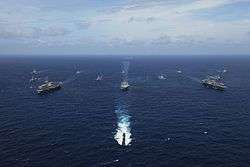
India and Japan also have close military ties. They have shared interests in maintaining the security of sea-lanes in the Asia-Pacific and Indian Ocean, and in co-operation for fighting international crime, terrorism, piracy and proliferation of weapons of mass destruction. The two nations have frequently held joint military exercises and co-operate on technology.[11] India and Japan concluded a security pact on 22 October 2008.[26][27]
Japanese Prime Minister Shinzo Abe is seen by some to be an "Indophile" and, with rising tensions in territorial disputes with Japan's neighbors, has advocated closer security cooperation with India.[28][29][30]
In July 2014, the Indian Navy participated in Exercise Malabar with the Japanese and US navies, reflecting shared perspectives on Indo-Pacific maritime security. India is also negotiating to purchase US-2 amphibious aircraft for the Indian Navy.[31]
Cultural

Japan and India have strong cultural ties, based mainly on Japanese Buddhism, which remains widely practiced through Japan Today.... .The Japanese culture is very well projected in India and otaku population will explode in 5 years in India due to ever increasing popularity of anime and J pop. The two nations announced 2007, the 50th anniversary year of Indo-Japan Cultural Agreement, as the Indo-Japan Friendship and Tourism-Promotion Year, holding cultural events in both the countries.[32][33] One such cultural event is the annual Namaste India Festival, which started in Japan over twenty years ago and is now the largest festival of its kind in the world.[34] [35] At the 2016 festival, representatives from Onagawa Town performed as a sign of appreciation for the support the town received from the Indian Government during the Great East Japan Earthquake.[36] Onagawa is the town where the Indian National Disaster Response Force (NDRF) team was dispatched as its very first overseas mission and conducted search and rescue operations for missing persons.[36]
Osamu Tezuka wrote biographical manga Buddha from 1972 to 1983. Recently, Japan has also supported the reconstruction of Nalanda University, an ancient Buddhist centre of learning and has agreed to provide financial assistance, and recently approached the Indian government with a proposal.[37]
Tamil movies are very popular in Japan and Rajnikanth is the most popular Indian star in the country.[38] Bollywood has become more popular among the Japanese people in recent decades,[39][40] and the Indian yogi and pacifist Dhalsim is one of the most popular characters in the Japanese video game series Street Fighter....
Starting from July 3, 2014 Japan issues multiple entry visas for the short term stay of Indian nationals.[41]
2016 nuclear deal
Indian Prime Minister Narendra Modi on his three-day visit to Japan in November 2016 signed a deal with his counterpart Shinzo Abe on nuclear energy.[42] Though deal has been in discussion between the two countries for six years before it was signed, the 2011 Fukushima nuclear disaster delayed it. This is the first time that Japan signs such deal with a non-signatory of Non-Proliferation Treaty. The deal gives Japan to supply nuclear reactors, fuel and technology, to India. This deal is to help in India build the six nuclear reactors planned in Delhi, to be completed by 2032.[43][44][45]
See also
- Foreign relations of India
- Foreign relations of Japan
- Buddhism in Japan
- Hinduism in Japan
- Indians in Japan
- Japanese people in India
- Japanese language education in India
- Japanese curry
- Yamuna Action Plan (YAP)
References
- 1 2 3 4 PM'S ADDRESS TO JOINT SESSION OF THE DIET, Indian Prime Minister's Office, 14 December 2006, retrieved 14 November 2009
- ↑ "2013 World Service Poll" (PDF), BBC
- 1 2 3 4 "Japan-India Relations". Japanese Ministry of Foreign Affairs. Retrieved 8 November 2008.
- ↑ Leupp, Gary P. (2003). Interracial Intimacy in Japan. Continuum International Publishing Group. p. 37. ISBN 0-8264-6074-7.
- ↑ Garten, Jeffrey (9 December 2006). "Really Old School". New York Times. Retrieved 8 November 2008.
- ↑ Leupp, Gary P. (2003). Interracial Intimacy in Japan. Continuum International Publishing Group. p. 35. ISBN 0-8264-6074-7.
- ↑ Leupp, Gary P. (2003). Interracial Intimacy in Japan. Continuum International Publishing Group. p. 49. ISBN 0-8264-6074-7.
- ↑ Leupp, Gary P. (2003). Interracial Intimacy in Japan. Continuum International Publishing Group. p. 52. ISBN 0-8264-6074-7.
- ↑ "India-Japan relations". Embassy of India, Tokyo. Archived from the original on 12 May 2008. Retrieved 8 November 2008.
- ↑ "History of The Japan-India Association". Retrieved 1 November 2009.
- 1 2 3 4 5 "Ambassador Ronen Sen's remarks at a luncheon meeting of the Japan Society in New York". Retrieved 8 November 2008.
- ↑ Das, Subrata Kumar. "Early light on the land of the rising sun". The Daily Star. Retrieved 16 September 2013.
- ↑ "Ambassador's Message". Retrieved 11 November 2008.
- ↑ Ian Sumner (2001). The Indian Army 1914-1947. Osprey Publishing. pp. 23–29.
- ↑ Joyce C. Lebra, Jungle Alliance, Japan and the Indian National Army (1971) p 20
- ↑ Nayar, Mandira (15 February 2007). "India, Japan and world peace". The Hindu. Chennai, India. Retrieved 11 November 2008.
- ↑ Mathai, M.O. (1979). My Days with Nehru. Vikas Publishing House.
- ↑ "Nehru and Non-alignment". P.V. Narasimha Rao. Mainstream Weekly. 2 June 2009. Retrieved 31 October 2009.
- ↑ Mansingh, Lalit. "India-Japan Relations" (PDF). Archived from the original (PDF) on 25 June 2007. Retrieved 11 November 2008.
- ↑ "Japanese Prime Minister Shinzo Abe to be Republic Day chief guest". timesofindia.indiatimes.com. PTI. 6 January 2014. Retrieved 6 January 2014.
- ↑ Iain Marlow (3 September 2014). "India's Modi maintains warm ties with Japan's Abe". The Globe and Mail.
- ↑ Dipanjan Roy Chaudhury (2 September 2014). "India, Japan sign key agreements; to share 'Special Strategic Global Partnership'". Economic Times.
- ↑ "India, Japan sign landmark civil nuclear deal - Times of India". The Times of India. Retrieved 11 November 2016.
- ↑ Roche, Elizabeth (11 November 2016). "India, Japan sign landmark civilian nuclear deal". Livemint. Retrieved 11 November 2016.
- ↑ "Japan PM Abe returns home after 'fruitful' India visit". 21 December 2015.
- ↑ "India And Japan Sign Security Pact". IndiaServer. 23 October 2008. Retrieved 19 October 2009.
- ↑ "Joint Declaration on Security Co-operation between Japan and India". Ministry of Foreign Affairs of Japan. 22 October 2008. Retrieved 19 October 2009.
- ↑ Ankit Panda (8 January 2014). "India-Japan Defense Ministers Agree To Expand Strategic Cooperation". The Diplomat. Retrieved 9 January 2014.
- ↑ Japan and India Bolster Trade and Defense Ties TIME
- ↑ Three reasons why Shinzo Abe’s visit to India is a game changer RT
- ↑ David Brewster. "Malabar 2014: a Good Beginning. Retrieved 13 August 2014".
- ↑ "Japan-India Friendship Year 2007". Retrieved 8 November 2008.
- ↑ "India, Japan committed to developing cultural ties". The Hindu. Chennai, India. 23 October 2007.
- ↑ "Namaste India Festival in Tokyo".
- ↑ "Namaste India 2016".
- 1 2 "Embassy of Japan in India".
- ↑ "Amartya Sen to head Nalanda University panel". Rediff. 26 May 2007. Retrieved 23 September 2009.
- ↑ "Rajinikanth magic in Japan, yet again - Firstpost". 27 June 2012.
- ↑ Bollywood bigwigs hope Japan fans are in it for keeps Japan Times
- ↑ Japan: The fast emerging market for Bollywood films CNN-IBN
- ↑ "Japan to issue multiple entry visa to Indians for short stay". IANS. news.biharprabha.com. Retrieved 3 July 2014.
- ↑ Dipankan Bandopadhyay. "India and the Nukes". Politics Now. Retrieved 15 November 2016.
- ↑ "India, Japan Sign Landmark Nuclear Energy Deal After 6 Years Of Talks: 10 Points". NDTV. NDTV. NDTV. Retrieved 12 November 2016.
- ↑ "India, Japan sign landmark civil nuclear deal - Times of India". The Times of India. Retrieved 12 November 2016.
- ↑ Bhattacherjee, Kallol, Kallol (11 November 2016). "Japan has option to scrap N-deal". The Hindu. Retrieved 12 November 2016.
Further reading
- Green, Michael. Japan, India, and the Strategic Triangle with China Strategic Asia 2011–12: Asia Responds to Its Rising Powers – China and India (2011)
- Joshi, Sanjana. "The Geopolitical Context of Changing Japan-India Relations." UNISCI Discussion Papers 32 (2014): 117-136. online
- Naidu, G. V. C. "India and East Asia: The Look East Policy." Perceptions (2013)18#1 pp: 53-74. online
- Nakanishi, Hiroaki. "Japan-India civil nuclear energy cooperation: prospects and concerns." Journal of Risk Research (2014): 1-16. online
- Thakur, Upendra. "India and Japan, a Study in Interaction During 5th Cent.-14th Cent. A.D." "Abhinav Publications"
External links
- Japan-India Relations Ministry of Foreign Affairs of Japan
- Research, Reference and Training Division (2008). India 2008 (PDF). New Delhi: Ministry of Information and Broadcasting, Government of India. ISBN 81-230-1488-0.

